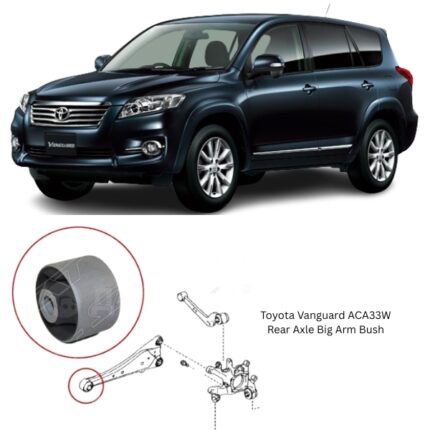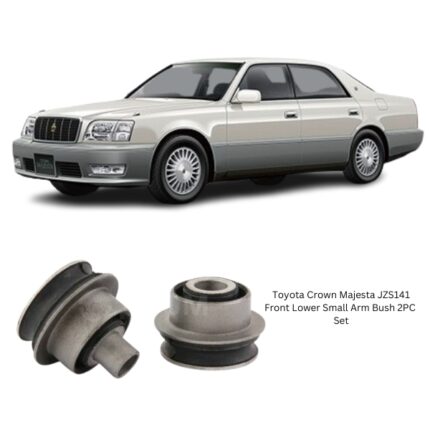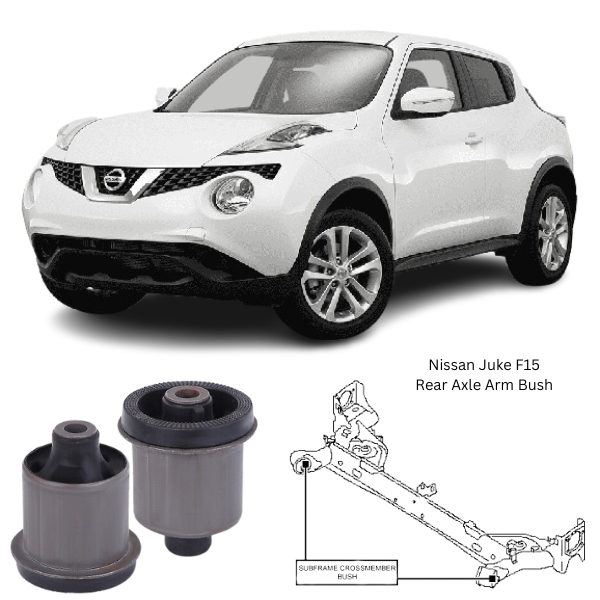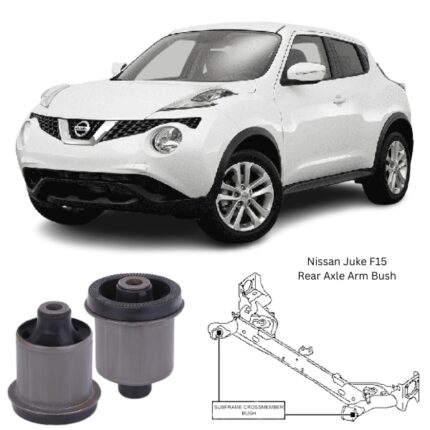Get Nissan Juke F15 Rear Axle Arm Bush 55501-1KK0A in Kenya
The Rear Axle Arm Bush is a critical component of the rear suspension system, serving as a flexible joint that connects the rear suspension arms to the vehicle chassis or subframe. Although relatively small in size, this bushing plays a significant role in ensuring that the vehicle handles safely, rides comfortably, and maintains proper alignment under various driving conditions.
Suspension bushes, including the rear axle arm bush, are designed to absorb shock, dampen vibration, and allow limited movement between metal components. By replacing rigid connections with elastic, rubber-based mounts, these bushings reduce noise, prevent wear, and improve overall ride quality. The rear axle arm bush, in particular, is subjected to constant dynamic loads and road shocks, especially during braking, cornering, and uneven terrain navigation.
Purpose and Functionality
The Rear Axle Arm Bush functions as a mechanical cushion between the rear suspension arm (also known as the trailing arm or control arm) and the chassis or rear axle. Its design allows a controlled range of motion, ensuring smooth articulation of the suspension system without compromising stability.
Core Functions:
-
Shock and Vibration Absorption
The bush absorbs impacts from the road, minimizing the transfer of harsh vibrations to the chassis and cabin. -
Flexible Suspension Movement
It provides controlled motion and flexibility, allowing the rear suspension arms to move up and down without causing metal-to-metal contact. -
Rear Axle Alignment Stability
Maintains proper geometry of the rear suspension, supporting consistent wheel alignment and handling. -
Noise Dampening
Reduces squeaks, rattles, and clunking noises that result from road shocks or worn suspension connections. -
Load Distribution
Helps distribute vehicle weight and driving loads evenly across the rear suspension assembly, reducing localized wear on other parts.
By performing these functions, the rear axle arm bush directly contributes to a vehicle’s comfort, road holding, and component longevity.
Design and Materials
The Rear Axle Arm Bush is engineered to endure mechanical stress, road debris, heat, moisture, and chemical exposure. It typically consists of a combination of metal and elastomeric material bonded together to provide strength and flexibility.
Standard Construction:
-
Outer Sleeve:
Made of galvanized steel or aluminum, this sleeve fits securely into the axle arm or control arm and serves as a fixed housing for the internal components. -
Inner Sleeve:
A cylindrical steel sleeve that receives the suspension bolt or fastener, allowing for a firm attachment to the subframe or chassis. -
Elastomer Core (Rubber or Polyurethane):
The core of the bush is composed of high-strength rubber or polyurethane. This material deforms slightly under load to absorb vibrations and allow movement, then returns to its original shape when the load is removed. -
Void Geometry or Tuning Grooves (in some designs):
Engineered voids or channels in the rubber allow for specific directional compliance, enhancing ride quality or performance under particular loading conditions. -
Bonding Adhesive:
The elastomer is bonded to the sleeves using a vulcanizing or chemical bonding process, ensuring long-term structural integrity.
Performance Features
An effective Rear Axle Arm Bush must deliver high-performance characteristics over a wide range of operating conditions:
-
Durability:
Designed to handle the rigors of daily driving, heavy loads, and varied terrain without breaking down or tearing. -
Resilience:
Withstands repeated flexing, temperature changes, and environmental exposure over tens of thousands of kilometers. -
Precision Fit:
Manufactured to exacting tolerances to ensure tight, secure fitment and consistent alignment. -
Noise, Vibration & Harshness (NVH) Reduction:
Minimizes unwanted cabin noise and harshness, especially over rough roads. -
Corrosion Resistance:
Coated or treated metal components prevent rust and degradation over time.
When maintained in good condition, the bush contributes to quiet operation, smooth handling, and vehicle stability.
Signs of Wear or Failure
Rear axle arm bushes are wear-and-tear items that naturally degrade over time due to road conditions, vehicle load, and environmental exposure. Recognizing the signs of wear can prevent damage to other suspension components and maintain vehicle safety.
Common Symptoms of a Failing Rear Axle Arm Bush:
-
Clunking or Banging Noises
Sounds from the rear of the vehicle when driving over bumps or during acceleration may indicate excessive play in the bush. -
Rear-End Instability
A worn bush may cause the rear axle or suspension arm to shift, leading to wandering, swaying, or loss of control during cornering. -
Excessive Vibration
Increased road vibrations felt through the chassis or rear seats can suggest the bush is no longer isolating motion effectively. -
Uneven Tire Wear
Misalignment from loose or torn bushes often results in uneven or premature tire wear, especially on the rear wheels. -
Visible Damage
Cracks, splits, or missing rubber in the bushing area are clear visual signs that replacement is needed. -
Brake Instability
Rear suspension movement during braking can cause a spongy or delayed brake feel if the bushes are worn.
Addressing these symptoms early prevents further damage and ensures safe driving conditions.
Installation Overview
Replacing a Rear Axle Arm Bush can vary in difficulty depending on the vehicle’s suspension layout. In most cases, professional installation is recommended, especially for press-fit bushings.
General Steps:
-
Vehicle Lift and Safety
Lift the vehicle securely and remove the relevant rear wheel for access. -
Component Disassembly
Remove the rear axle arm or trailing arm from the vehicle. -
Old Bushing Removal
Use a bushing press or removal tool to press out the worn bushing. Avoid damaging the housing or mounting surfaces. -
New Bushing Installation
Press the new bush into the arm using correct tools and alignment methods. Ensure the orientation is correct for any directional voids. -
Reinstallation and Torqueing
Reinstall the arm onto the vehicle and torque all bolts to the manufacturer’s specification. -
Alignment Check
Perform a rear wheel alignment after installation to restore correct geometry.
Maintenance and Inspection
While bushes are not typically replaced as part of routine maintenance, they should be inspected during:
-
Suspension overhauls
-
Shock absorber or spring replacement
-
Brake servicing
-
Regular vehicle inspections
Vehicles driven in harsh conditions (gravel roads, heavy loads, potholes) may require more frequent inspection.
Benefits of Replacing Worn Bushes
-
Restored Ride Comfort
Eliminates vibration and shock that can degrade passenger comfort. -
Improved Handling
Ensures the rear axle remains aligned and responsive under load. -
Noise Reduction
Removes rattling or clunking caused by movement between metal parts. -
Prolonged Tire and Suspension Life
Reduces uneven wear and mechanical stress on suspension components. -
Enhanced Vehicle Safety
Maintains traction, especially during emergency braking or evasive maneuvers.
Follow us on Facebook for more parts.





Reviews
Clear filtersThere are no reviews yet.